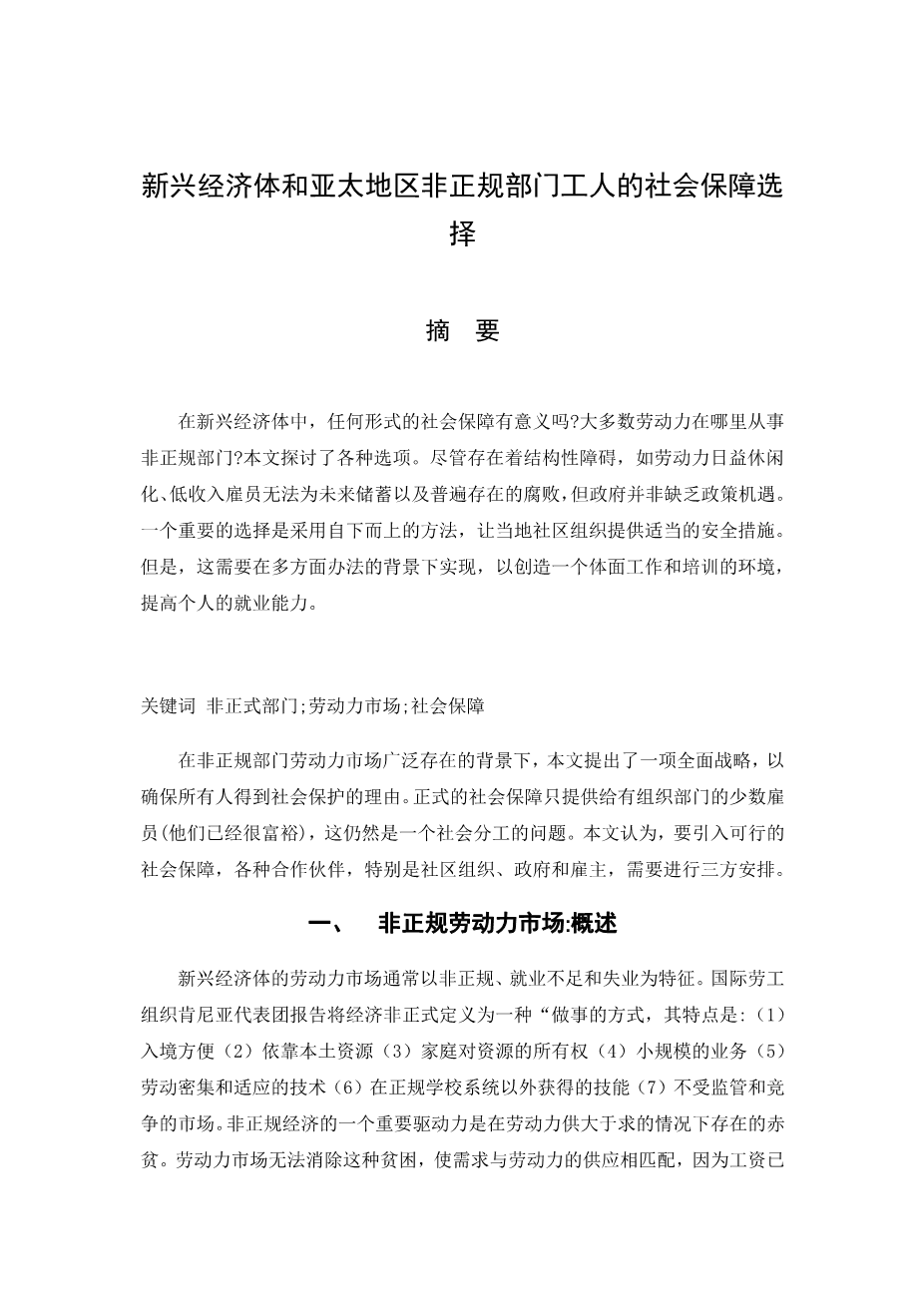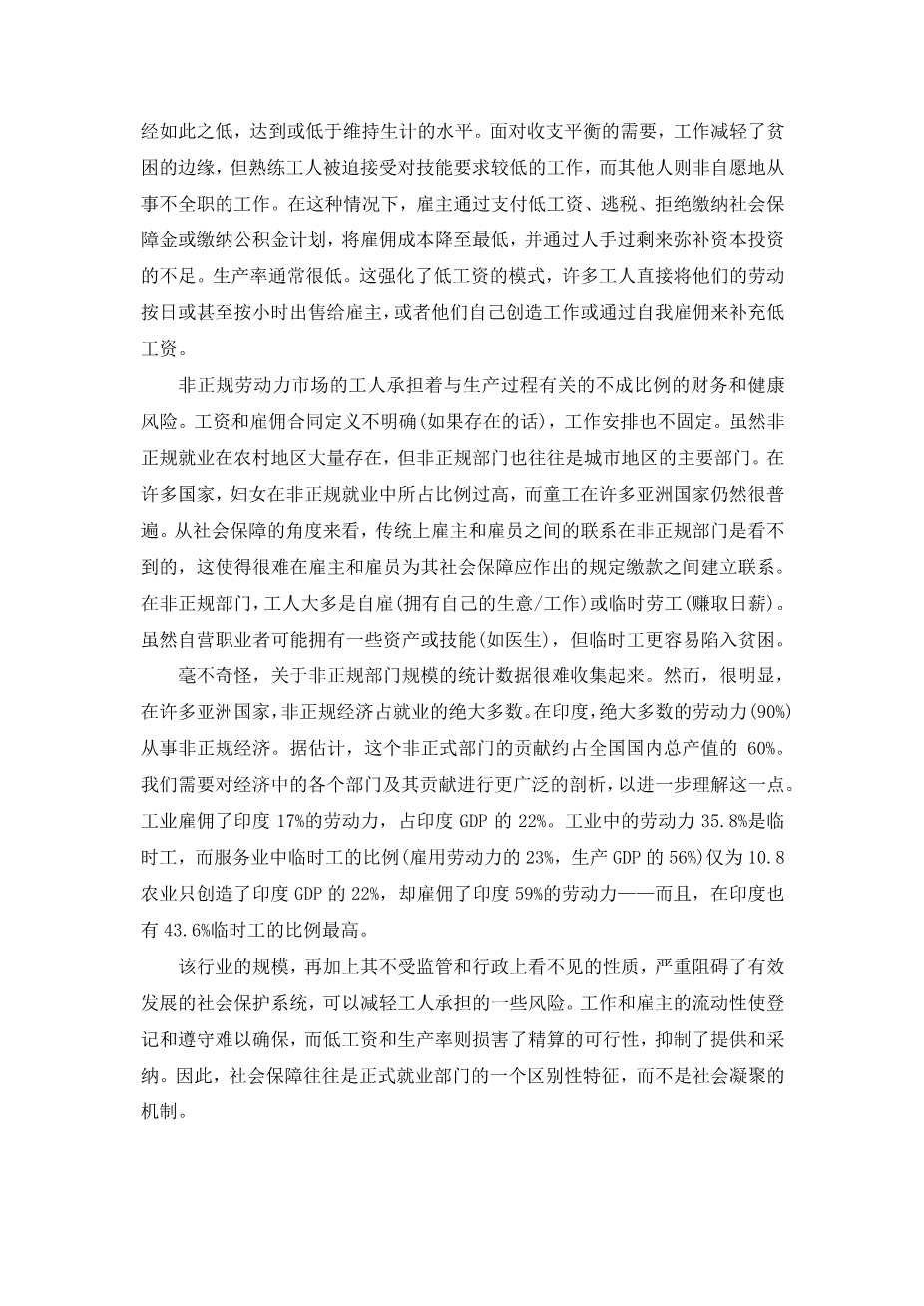Social Security Options for Informal Sector Workers in Emergent Economies and the Asia and Pacific Region
Abstract : Does any form of social security make sense in emergent economies, such as those in Asia and the Pacific, where most of the labour force is involved in the informal sector? This article explores various options. Though there are structural obstacles, such as the increasing casualization of labour, the inability of low paid employees to save for the future and widespread corruption, the state is not devoid of policy opportunities. A bottom-up approach engaging local community organizations to provide suitable security measures is one important option. However, this needs to be achieved in the context of a multifaceted approach to create an environment of decent work and training that increases individualsrsquo; employability.
Keywords: Informal sector; Labour market; Social security
In the context of a widespread informal sector labour market, this article argues the case for a comprehensive strategy for ensuring social protection for all. Formal social security being provided only for the minority of employees in the organized sector (who are already well off ), this has remained an issue of social division. This article argues that to introduce viable social security, a variety of partners, particularly community organizations, government and employers, need to engage in a tripartite arrangement.
The Informal Labour Market: an Overview
Labour markets in emergent economies are often characterized by informality, underemployment and unemployment. The International Labour Organiza-tionrsquo;s Kenya Mission Report of defined economic informality as a lsquo;way of doing things, characterized by: (i) ease of entry; (ii) reliance on indigenous resources; (iii) family ownership of resources; (iv) small scale of operations; (v) labour intensive and adapted technology; (vi) skill acquired outside the formal school system; and (vii) unregulated and competitive marketsrsquo; (cited in Mathew 2006:107). An important driver of the informal economy is the existence of abject poverty in the context of a labour supply that exceeds demand. The labour market is unable to clear this poverty so that the demand matches the supply of labour, because wages are already so low that they are at or below subsistence level. Faced with the need to make ends meet, jobs take the edge off destitution, but skilled workers are forced to accept jobs requiring less skill, while others involuntarily work less than full time. In such settings, employers minimize employment costs by paying low wages, evading taxes and refusing to meet social security contributions or to contribute to provident schemes, and they compensate for their lack of capital investment by overstaffing. Productivity is typically low. This reinforces the pattern of low wages and many workers directly sell their labour to employers on a daily or even hourly basis, or else they create their own work or supplement low wages through self-employment.
Workers in an informal labour market bear a disproportionate portion of the risks, both financial and health-based, associated with the production process. Wage and employment contracts are ill-defined – if they exist at all – and work arrangements are fluid. While informal employment exists on a large scale in rural areas, the informal sector is also often the dominant sector in urban areas. In many countries, women account for a disproportionate share of informal employment, while child labour remains prevalent in many Asian countries (ILO 2004). From a social security perspective, the traditional linkage between employer and employee is invisible in the informal sector, rendering it difficult to make a connection between the defined contributions that employers and employees should be making for their social security. In the informal sector the workers are largely either self-employed (having own business/ work) or casual labourers (earning daily wages). While self-employed persons may have some assets or skills (as in the case of doctors), casual labourers are more vulnerable to poverty.
Not surprisingly, statistics on the size of the informal sector are difficult to assemble. Nevertheless, it is clear that in many Asian countries the informal economy accounts for the vast majority of employment. In India, an overwhelming 90 percent of the labour force is engaged in the informal economy. It is estimated that this informal sector contributes about 60 percent of national GDP. We need a more extensive dissection of the various sectors in the economy and their contribution to it, to understand this further. Industry, which employs 17 percent of the Indian workforce, accounts for 22 percent of GDP. Of the workforce in industry, 35.8 percent are casual labourers, whereas the share of casual labourers in the service sector (employing 23 percent of the workforce and producing 56 percent of GDP) is as low as 10.8 per cent. Agriculture, which produces only 22 per cent of GDP, employs 59 per cent of the Indian labour force – and has, at 43.6 per cent, the highest proportion of casual labourers (Ghose 2004).
The scale of the sector, combined with its unregulated and administratively invisible nature, imposes a major brake on the development of effective systems of social protection that might alleviate some of the risks borne by workers. The fluidity of jobs and employers makes registration and compliance difficult to ensure, while low wages and productivity undermine actuarial viability and inhibit provision and uptake. Consequently, social security often serves as a discriminating feature of the formal employment sector, rather than as a mechanism for social cohesion.
Obstacles in the Way of Social Security Options
While globalization helps to set the parameters for such developments, governments are not devoid of policy choices. For example, across the So
剩余内容已隐藏,支付完成后下载完整资料


英语译文共 8 页,剩余内容已隐藏,支付完成后下载完整资料
资料编号:[590770],资料为PDF文档或Word文档,PDF文档可免费转换为Word
以上是毕业论文外文翻译,课题毕业论文、任务书、文献综述、开题报告、程序设计、图纸设计等资料可联系客服协助查找。


